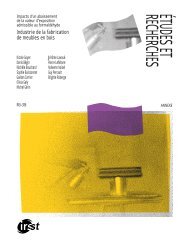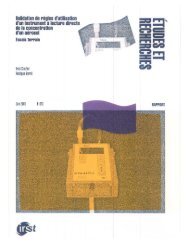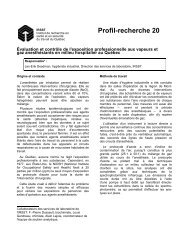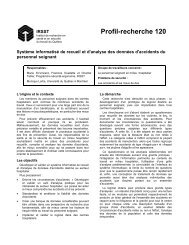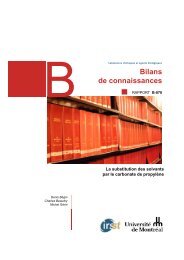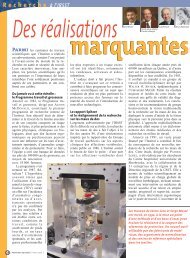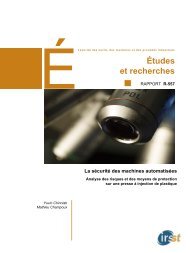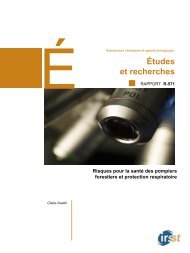Sampling Guide for Air Contaminants in the Workplace - Irsst
Sampling Guide for Air Contaminants in the Workplace - Irsst
Sampling Guide for Air Contaminants in the Workplace - Irsst
You also want an ePaper? Increase the reach of your titles
YUMPU automatically turns print PDFs into web optimized ePapers that Google loves.
IRSST – <strong>Sampl<strong>in</strong>g</strong> <strong>Guide</strong> <strong>for</strong> <strong>Air</strong> <strong>Contam<strong>in</strong>ants</strong> <strong>in</strong> <strong>the</strong> <strong>Workplace</strong> 31<br />
2.5.4 Specific considerations<br />
The shipp<strong>in</strong>g times are 48 hours when growth characterization is requested, whereas <strong>the</strong>re is no specific time<br />
frame <strong>for</strong> mycological structure analysis.<br />
The samples must be shipped to <strong>the</strong> laboratory with<strong>in</strong> 24 hours of <strong>the</strong>ir collection. Any delay must be noted <strong>in</strong><br />
order to ensure <strong>the</strong> validity of <strong>the</strong> results.<br />
2.5.5 Analytical methods<br />
Two methods are available <strong>for</strong> evaluat<strong>in</strong>g viable bacteria and moulds. The basic method consists of count<strong>in</strong>g<br />
<strong>the</strong> colonies <strong>for</strong>med follow<strong>in</strong>g an <strong>in</strong>cubation period specific to <strong>the</strong> <strong>in</strong>vestigated microorganisms. Count<strong>in</strong>g is<br />
done by optical microscopy. Subsequently, if <strong>the</strong> situation justifies it, identification can be done. To do this,<br />
each of <strong>the</strong> different colonies found on <strong>the</strong> <strong>in</strong>itial agar must be re<strong>in</strong>oculated on a specific agar, <strong>in</strong>cubated<br />
aga<strong>in</strong>, and identified by different techniques. Bacteria are identified by a series of biochemical tests or by<br />
analysis of <strong>the</strong>ir fatty acid profile, while moulds are identified by morphological observation.<br />
Transmitted light microscopy is used <strong>for</strong> mycological structure characterization analysis. Observation is done<br />
directly on <strong>the</strong> slide or on an aliquot of <strong>the</strong> suspension collected after extraction of <strong>the</strong> supplied materials<br />
(sponge, bulk) placed between <strong>the</strong> slide and cover slip.<br />
Endotox<strong>in</strong>s are analyzed us<strong>in</strong>g <strong>the</strong> limulus amebocyte lysate (LAL) method and <strong>the</strong> determ<strong>in</strong>ation is done by<br />
k<strong>in</strong>etic chromogenic analysis us<strong>in</strong>g a spectrometer at a wavelength of 405 nm.<br />
The technical guide Bioaerosols <strong>in</strong> <strong>the</strong> <strong>Workplace</strong>: Evaluation, Control and Prevention <strong>Guide</strong> (24) describes<br />
<strong>the</strong> process recommended by <strong>the</strong> IRSST <strong>for</strong> prevent<strong>in</strong>g, controll<strong>in</strong>g and evaluat<strong>in</strong>g microorganisms <strong>in</strong> <strong>the</strong><br />
workplace. It is recommended that this document be consulted when plann<strong>in</strong>g an <strong>in</strong>tervention.<br />
Due to <strong>the</strong> complexity and <strong>the</strong> time required <strong>for</strong> bioaerosol identification and endotox<strong>in</strong> determ<strong>in</strong>ation, a prior<br />
agreement must be arrived at with <strong>the</strong> person <strong>in</strong> charge of <strong>the</strong> IRSST's microbiology laboratory. For <strong>the</strong>se<br />
same reasons, when <strong>the</strong> count is below 250 CFU /m³, <strong>the</strong> species will not be identified.<br />
2.6 Samples orig<strong>in</strong>at<strong>in</strong>g from a bulk<br />
Samples orig<strong>in</strong>at<strong>in</strong>g from a process or start<strong>in</strong>g materials (commonly called bulk samples) are sent to <strong>the</strong><br />
laboratory <strong>in</strong> <strong>the</strong> three follow<strong>in</strong>g cases.<br />
2.6.1 As a reference product<br />
The substance is used or can be used as a calibration solution. This is <strong>the</strong> case when analyz<strong>in</strong>g mixtures of<br />
hydrocarbons such as VM & P naphtha, Stoddard solvent and rubber solvent (25). In <strong>the</strong>se cases, <strong>the</strong><br />
reference solutions are complex mixtures of hydrocarbons of variable composition. It may be necessary to use<br />
<strong>the</strong> mixture found <strong>in</strong> <strong>the</strong> workplace as <strong>the</strong> calibration solution, s<strong>in</strong>ce it is <strong>the</strong> source of exposure.<br />
2.6.2 Composition analysis<br />
A start<strong>in</strong>g material or a deposited dust is sent <strong>for</strong> analysis when all o<strong>the</strong>r means of obta<strong>in</strong><strong>in</strong>g <strong>in</strong><strong>for</strong>mation have<br />
proven <strong>in</strong>effective; this <strong>in</strong>cludes reviews of <strong>the</strong> literature, and consult<strong>in</strong>g <strong>the</strong> supplier, manufacturer and <strong>the</strong><br />
CSST's Répertoire toxicologique (Toxicological Index).<br />
When a composition analysis is requested, <strong>the</strong> follow<strong>in</strong>g <strong>in</strong><strong>for</strong>mation must be provided: <strong>the</strong> type of <strong>in</strong>dustry,<br />
<strong>the</strong> nature of <strong>the</strong> process, <strong>the</strong> type of exposure, <strong>the</strong> exposure-related health problems, <strong>the</strong> suspected chemicals,<br />
and particularly <strong>the</strong> safety data sheet when a commercial substance is <strong>in</strong>volved.<br />
2.6.2.1 Liquids<br />
Organic<br />
For organic solvents, analysis can be carried out us<strong>in</strong>g <strong>the</strong> solution, or preferably, saturated activated charcoal



